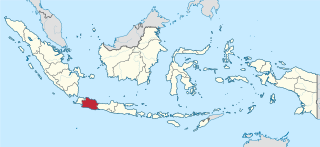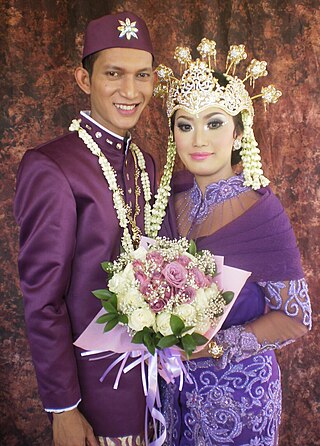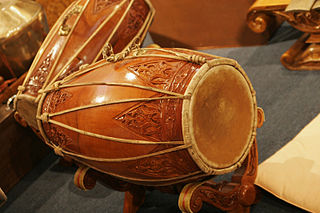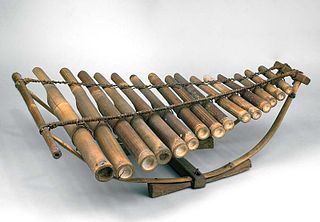
Gamelan is the traditional ensemble music of the Javanese, Sundanese, and Balinese peoples of Indonesia, made up predominantly of percussive instruments. The most common instruments used are metallophones and a set of hand-drums called kendang, which keep the beat. The kemanak, a banana-shaped idiophone, and the gangsa, another metallophone, are also commonly used gamelan instruments on Bali. Other notable instruments include xylophones, bamboo flutes, a bowed string instrument called a rebab, and a zither-like instrument called a siter, used in Javanese gamelan. Additionally, vocalists may be featured, being referred to as sindhen for females or gerong for males.

Indonesia is a country with many different tribes and ethnic groups, and its music is also very diverse, coming in hundreds of different forms and styles. Every region has its own culture and art, and as a result traditional music from area to area also uniquely differs from one another. For example, each traditional type of music is often accompanied by its very own dance and theatre. Contemporary music scene have also been heavily shaped by various foreign influences, such as America, Britain, Japan, Korea, and India.

Celempungan is a Sundanese musical genre that includes several musical instruments such as kacapi, kendang, goong/gong, and suling or rebab (optional), and Juru Kawih (singer). Kendang, the drum, controls the tempo of the ensemble and reinforces the meter.

West Java is an Indonesian province on the western part of the island of Java, with its provincial capital in Bandung. West Java is bordered by the province of Banten and the country's capital region of Jakarta to the west, the Java Sea to the north, the province of Central Java to the east and the Indian Ocean to the south. With Banten, this province is the native homeland of the Sundanese people, the second-largest ethnic group in Indonesia.

Pelog is one of the essential tuning systems used in gamelan instruments that has a heptatonic scale. The other, older, scale commonly used is called slendro. Pelog has seven notes, but many gamelan ensembles only have keys for five of the pitches. Even in ensembles that have all seven notes, many pieces only use a subset of five notes, sometimes the additional 4th tone is also used in a piece like western accidentals.

The angklung is a musical instrument from the Sundanese in Indonesia that is made of a varying number of bamboo tubes attached to a bamboo frame. The tubes are carved to produce a resonant pitch when struck and are tuned to octaves, similar to Western handbells. The base of the frame is held in one hand, while the other hand shakes the instrument, causing a repeating note to sound. Each performer in an angklung ensemble is typically responsible for just one pitch, sounding their individual angklung at the appropriate times to produce complete melodies.

The Music of Java embraces a wide variety of styles, both traditional and contemporary, reflecting the diversity of the island and its lengthy history. Apart from traditional forms that maintain connections to musical styles many centuries old, there are also many unique styles and conventions which combine elements from many other regional influences, including those of neighbouring Asian cultures and European colonial forms.

The Sundanese are an indigenous ethnic group native to the western region of Java island in Indonesia, primarily West Java. They number approximately 42 million and form Indonesia's second most populous ethnic group. They speak the Sundanese language, which is part of the Austronesian languages.

Jaipongan, also known as Jaipong is a popular traditional dance of Sundanese people from Indonesia. The dance was created by Gugum Gumbira, based on the traditional Sundanese Ketuk Tilu music and pencak silat movements.

A kendang or gendang is a two-headed drum used by people from the Indonesian Archipelago. The kendang is one of the primary instruments used in the gamelan ensembles of Javanese, Sundanese, and Balinese music. It is also used in various Kulintang ensembles in Indonesia, Brunei, Malaysia, Singapore, and the Philippines. It is constructed in a variety of ways by different ethnic groups. It is related to the Indian double-headed mridangam drum.

Kroncong is the name of a ukulele-like instrument and an Indonesian musical style that typically makes use of the kroncong. A kroncong orchestra or ensemble traditionally consists of a flute, a violin, at least one, but usually a pair of kroncongs, a cello in Pizzicato style, string bass in pizzicato style, and a vocalist. Kroncong originated as an adaptation of a Portuguese musical tradition, brought by sailors to Indonesian port cities in the 16th century. By the late 19th century, kroncong reached popular music status throughout the Indonesian archipelago.

Gamelan, although Indonesia is its origin place, is found outside of that country. There are forms of gamelan that have developed outside Indonesia, such as American gamelan and Malay Gamelan in Malaysia.

The Calung is a type of Indonesian bamboo xylophone originating from Baduy culture and commonly used in Baduy, Bantenese, Sundanese, Banyumasan, and Balinese performances. The calung (instrument) consists of multiple bamboo tubes which are struck at the base to produce a woody sound.
Raden Machjar Angga Koesoemadinata, known as Pak Machjar or Pak Mahyar, was a Sundanese music composer and an Indonesian musicologist, specializing in pelog and salendro. He invented the Sundanese solfège system and the Sundanese 17-tone model. He was born in Sumedang on 7 December 1902, and died in Bandung on 9 April 1979.

The Harmony Chinese Music Group (和聲中樂團) is a Chinese music group founded in 2001 in Bandung, Indonesia. The group seeks to promote a wide variety of world music based on Indonesian culture using Chinese musical instruments, as well as exploring contemporary styles.

Sundanese dances is a dance tradition that is a part of ritual, artistic expression as well as entertainment and social conduct among the Sundanese people of West Java and Banten, Indonesia. Sundanese dance is usually cheerful, dynamic and expressive, with flowing movements in-sync with the beat of kendang accompanied with Gamelan degung music ensemble.

Sandiwara is a genre of traditional theatrical drama of Indonesia. In general, it refers to any kind of drama or theatrical performance, and literally, sandiwara means "to pretend" or "to act". However, the term is often used to describe a genre of traditional drama of West Java. Sandiwara Sunda is a type of sandiwara performed in Sundanese and presenting Sundanese themes, folklores and stories. It is quite similar to Javanese ketoprak or wayang orang.

West Java Syndicate is an Indonesian ethnic-fusion music group founded in 2010 in Bandung, Indonesia. The group seeks to promote a wide variety of world music based on Sundanese music using traditional Sundanese musical instruments, as well as exploring contemporary styles.
Detty Kurnia was an Indonesian vocalist who sang pop sunda by blending traditional Indonesian music with western music. She started singing at a young age, and released her record at the age of 11. Under a recording contract with Japanese Wave Records, in the year 1991 she recorded the album, Dari Sunda. She also had some songs in the album the Rough Guide to the Music of Indonesia. She was an iconic singer in the well known Indonesian musical genre of dangdut a folk and traditional music. Her song Dari Sunda in the Pop Sunda-style was among the five best albums listed by Q Magazine and acclaimed as "an imaginative, inventive gem throughout with Kurnia's mellow smile of a voice effortlessly binding everything together."

Sundanese Music is an umbrella term that encompasses diverse musical traditions of the West Java and Banten in western part of Java, Indonesia. The term of "West Java" is preferred by scholars in this field. The word "Sundanese" originally referred to western part of Java Island and has a strong association with the highly centralized Sunda Kingdom based on Java Island and its high culture practiced by the nobleman class in its capital Parahyangan. By contrast, scholars who cover a much broader region lay emphasis on folk culture.
















